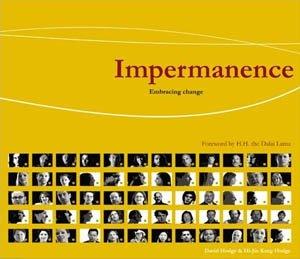Impermanence: Embracing Change

It's day five of my computer's meltdown. This morning the dishwasher broke. My husband has no job leads. My doctor emailed me this afternoon, and there are no new answers to my health issues. As my husband flew out the door to another networking event, I couldn’t help a somewhat desperate whimper, "Are we destined for instability?" If we are, we are in good company. In the company of the whole world, according to Impermanence: Embracing Change by married multimedia artists David Hodge and Hi-Jin Kang Hodge. Impermanence focuses on the Buddhist concept of change which teaches that instability, change, impermanence, call it what you will, is a fact of life. Accepting that sands inevitably shift is a necessary path to stability and peace of mind. Impermanence is a valuable way station on this rocky, cliff-hugging journey.
While Impermanence is packaged as a book and DVD set, it is so much more. It is an art exhibit you hold in your hand. And view on your DVD player. Its first incarnation was as part of the traveling art installation, The Missing Peace, a celebration of the Dalai Lama’s life and work. The Hodges filmed a diverse group of 108 women and men discussing impermanence. The interviews played on sixteen iPods arranged in a circle and set to play at both timed intervals and simultaneously.
Transferred to DVD, the exhibit feels like a friendly cocktail party where the host has banned superficial chitchat and commanded guests to talk only about life’s enduring matters. It starts as a mosaic of faces and a soft cacophony of voices. It is interactive. Let the film take control as it moves between mosaic and individual or click on arrows which arrange the interviews into themes such as "awareness," "message to the world," and "presence." Either way, just like that, you are launched into the exhibit as if you were there.
The interviewees each speak for several minutes about impermanence. Is it a source of dread? A harbinger of death and loss? The other shoe dropping?
Or is it proof that one is alive? Nature’s way of making us appreciate the here and now? Promise of a better tomorrow?
Yes.
Impermanence is all of this. Several interviewees also emphasize its potential to unite: we all have impermanence in common. In addition, letting go of our own little corner of status quo leaves us open to new connections.
The book adds even more depth. It is arranged into the same themes as the DVD, each introduced by an enlightening and thoughtful essay or poem. Photographs of the participants and snippets of their interviews follow.
Impermanence is uplifting and depressing, energizing and draining. In fact, it feels a lot like life. While I thought women might struggle more with change as we seem disproportionately affected by it during life events such as marriage, childbirth and divorce, this turned out not to be so. Women and men equally expressed hope and trepidation.
Impermanence would have been an even more absorbing experience had it included less philosophy and more anecdote. But its overall message of accepting impermanence without fighting it, of refusing to feel defeated by change even when it's in the wrong direction and of remembering that impermanence allows for the possibility of better times, not just worse, is invaluable. In the time since I began this review, the computer and dishwasher were fixed. And Impermanence has persuaded me to focus on what is, instead of lamenting what will surely be the continuing ebb and flow of life.
A fantastic book and art project for anyone seeking the meaning of some of Life's most universal and challenging aspects. Well done David and Hi-Jin Hodge.